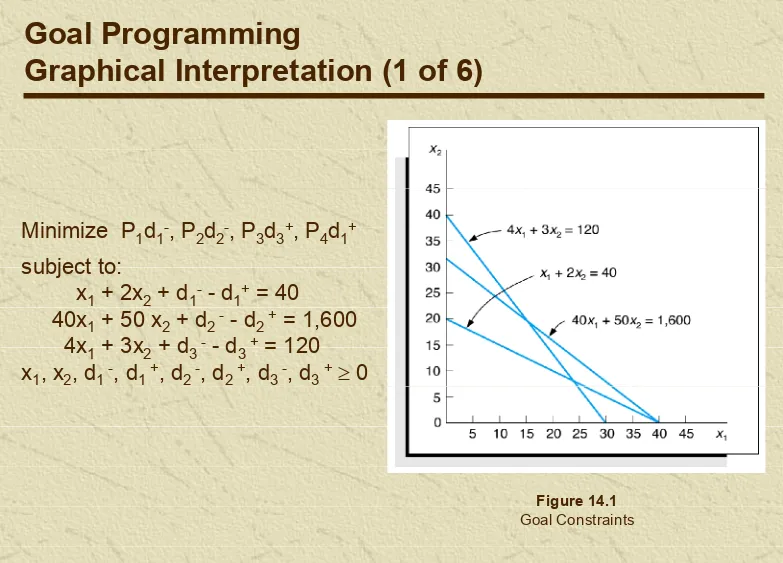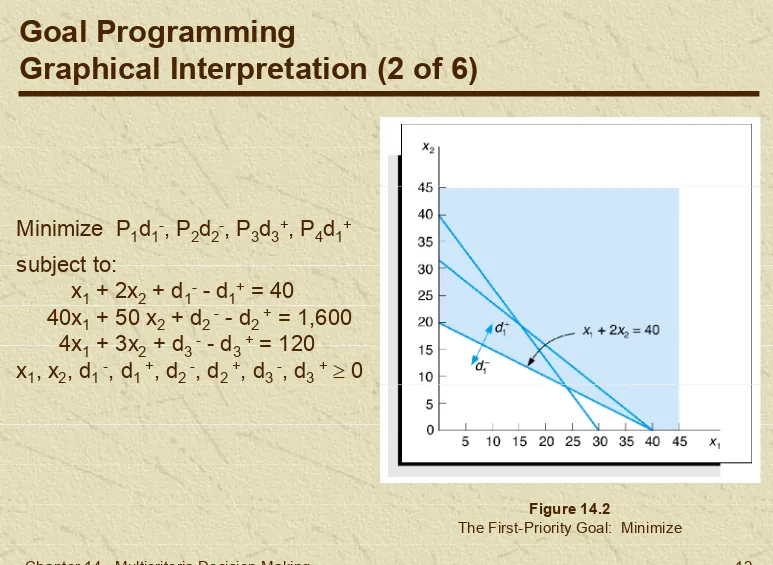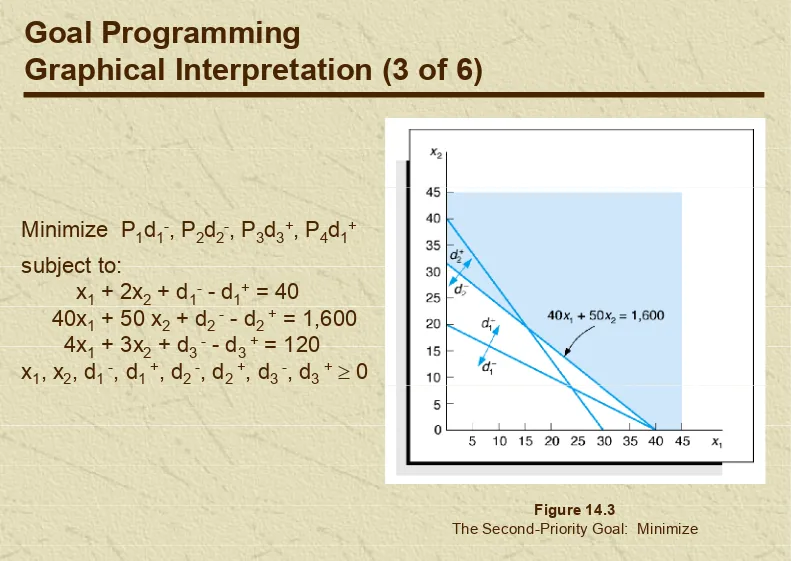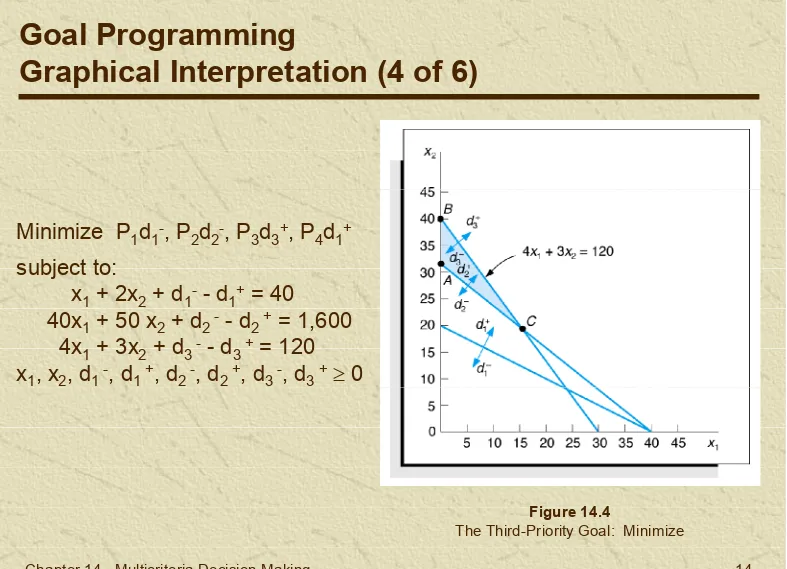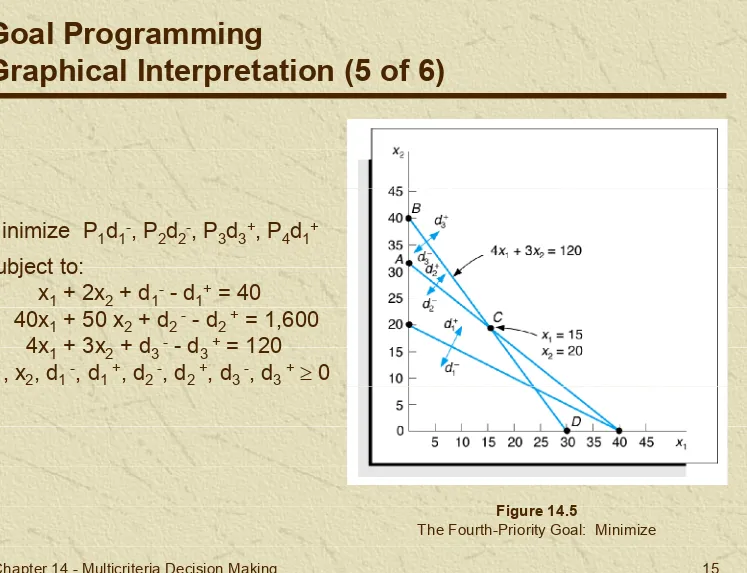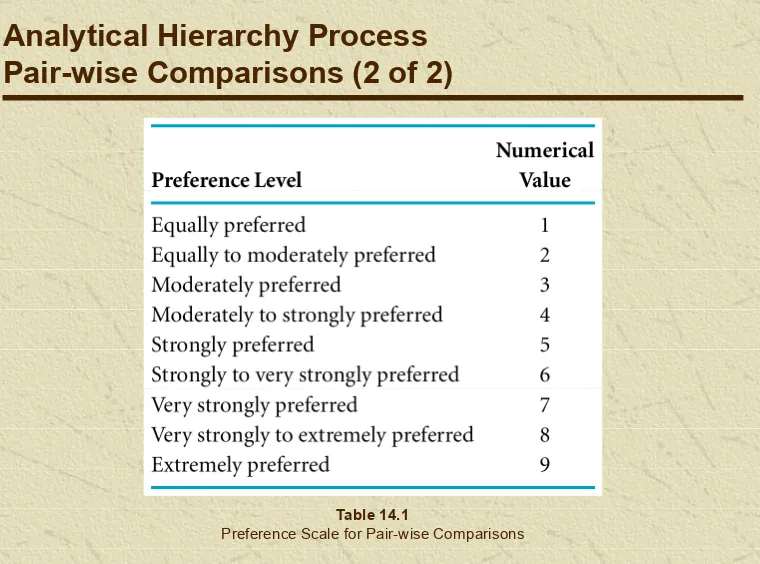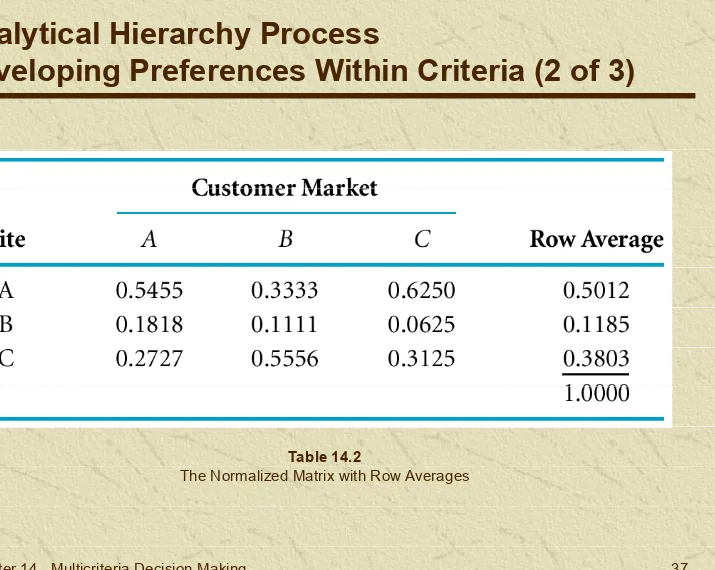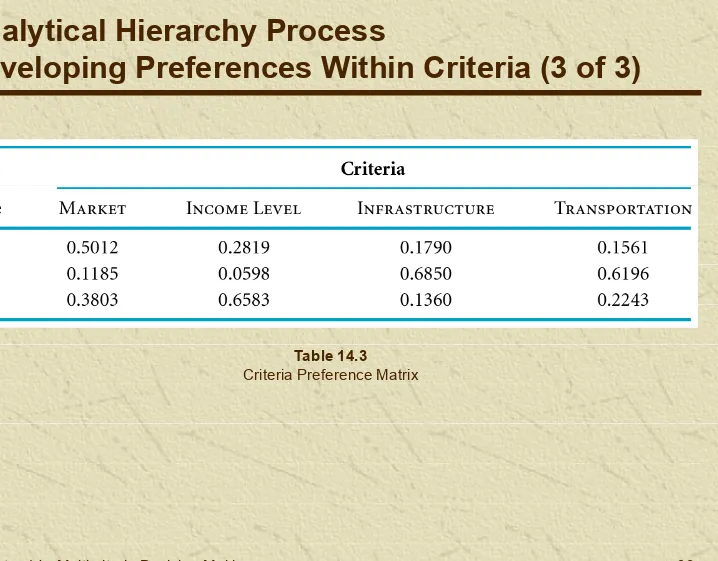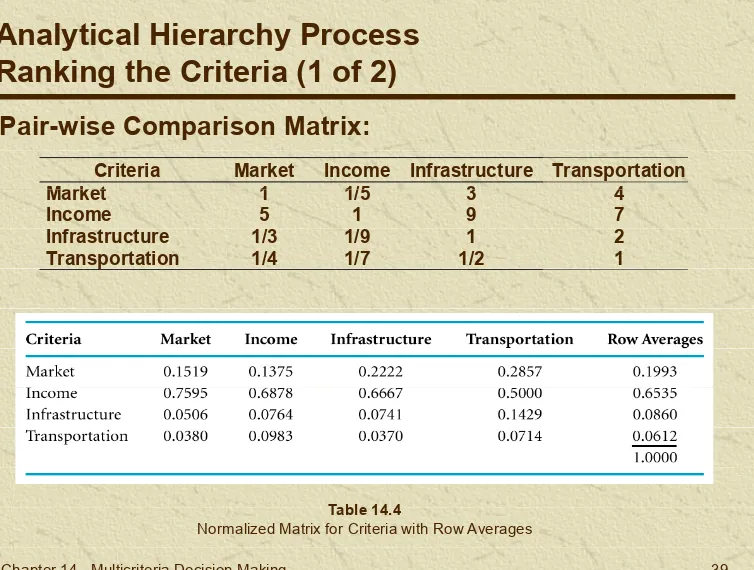Introduction to Management Science
(8th Edition, Bernard W. Taylor III)
Chapter 14
Goal Programming
Graphical Interpretation of Goal Programming
Computer Solution of Goal Programming Problems with
Chapter Topics
Computer Solution of Goal Programming Problems with QM for Windows and Excel
Study of problems with several criteria, multiple criteria,
instead of a single objective when making a decision.
Two techniques discussed: goal programming, and the
Overview
Two techniques discussed: goal programming, and the
analytical hierarchy process.
Goal programming is a variation of linear programming considering more than one objective (goals)
in the objective function.
Beaver Creek Pottery Company Example:
Maximize Z = $40x1 + 50x2
Goal Programming
Model Formulation (1 of 2)
subject to:
1x1 + 2x2 40 hours of labor 4x2 + 3x2 120 pounds of clay x1, x2 0
Adding objectives (goals) in order of importance, the company:
Does not want to use fewer than 40 hours of labor per
Goal Programming
Model Formulation (2 of 2)
Does not want to use fewer than 40 hours of labor per day.
Would like to achieve a satisfactory profit level of $1,600 per day.
Prefers not to keep more than 120 pounds of clay on hand each day.
hand each day.
All goal constraints are equalities that include deviational variables d- and d+.
A positive deviational variable (d+) is the amount by which a
Goal Programming
Goal Constraint Requirements
A positive deviational variable (d+) is the amount by which a
goal level is exceeded.
A negative deviation variable (d-) is the amount by which a
goal level is underachieved.
At least one or both deviational variables in a goal constraint must equal zero.
constraint must equal zero.
Labor goals constraint (1, less than 40 hours labor; 4, minimum overtime):
Goal Programming
Goal Constraints and Objective Function (1 of 2)
Minimize P1d1-, P
4d1+
Add profit goal constraint (2, achieve profit of $1,600):
Minimize P1d1-, P
2d2-, P4d1+
Add material goal constraint (3, avoid keeping more than 120 pounds of clay on hand):
120 pounds of clay on hand):
Minimize P1d1-, P
Complete Goal Programming Model:
Minimize P1d1-, P
2d2-, P3d3+, P4d1+
Goal Programming
Goal Constraints and Objective Function (2 of 2)
subject to:
x1 + 2x2 + d1- - d
1+ = 40
40x1 + 50 x2 + d2 - - d
2 + = 1,600
4x1 + 3x2 + d3 - - d
3 + = 120
x1, x2, d1 -, d
Changing fourth-priority goal limits overtime to 10 hours instead of minimizing overtime:
d - + d - - d + = 10
Goal Programming
Alternative Forms of Goal Constraints (1 of 2)
d1- + d
4 - - d4+ = 10
minimize P1d1 -, P
2d2 -, P3d3 +, P4d4 +
Addition of a fifth-priority goal- “important to achieve the goal for mugs”:
x1 + d5 - = 30 bowls
x2 + d6 - = 20 mugs
minimize P1d1 -, P
-Goal Programming
Alternative Forms of Goal Constraints (2 of 2)
Complete Model with New Goals:
Minimize P1d1-, P
2d2-, P3d3-, P4d4-, 4P5d5-, 5P5d6
-subject to:
x1 + 2x2 + d1- - d
1+ = 40
40x1 + 50x2 + d2- - d
2+ = 1,600
4x1 + 3x2 + d3- - d
3+ = 120
d1+ + d
4- - d4+ = 10
x1 + d5- = 30
x + d1 5- = 20
x2 + d6- = 20
x1, x2, d1-, d
Goal Programming
Graphical Interpretation (1 of 6)
Minimize P1d1-, P
2d2-, P3d3+, P4d1+
subject to:
x1 + 2x2 + d1- - d
1+ = 40
40x1 + 50 x2 + d2 - - d
2 + = 1,600
4x1 + 3x2 + d3 - - d
3 + = 120
x1, x2, d1 -, d
1 +, d2 -, d2 +, d3 -, d3 + 0
Figure 14.1
Goal Programming
Graphical Interpretation (2 of 6)
Minimize P1d1-, P
2d2-, P3d3+, P4d1+
subject to:
x1 + 2x2 + d1- - d
1+ = 40
40x1 + 50 x2 + d2 - - d
2 + = 1,600
4x1 + 3x2 + d3 - - d
3 + = 120
x1, x2, d1 -, d
1 +, d2 -, d2 +, d3 -, d3 + 0
Figure 14.2
Goal Programming
Graphical Interpretation (3 of 6)
Minimize P1d1-, P
2d2-, P3d3+, P4d1+
subject to:
x1 + 2x2 + d1- - d
1+ = 40
40x1 + 50 x2 + d2 - - d
2 + = 1,600
4x1 + 3x2 + d3 - - d
3 + = 120
x1, x2, d1 -, d
1 +, d2 -, d2 +, d3 -, d3 + 0
Figure 14.3
Goal Programming
Graphical Interpretation (4 of 6)
Minimize P1d1-, P
2d2-, P3d3+, P4d1+
subject to:
x1 + 2x2 + d1- - d
1+ = 40
40x1 + 50 x2 + d2 - - d
2 + = 1,600
4x1 + 3x2 + d3 - - d
3 + = 120
x1, x2, d1 -, d
1 +, d2 -, d2 +, d3 -, d3 + 0
Figure 14.4
Goal Programming
Graphical Interpretation (5 of 6)
Minimize P1d1-, P
2d2-, P3d3+, P4d1+
subject to:
x1 + 2x2 + d1- - d
1+ = 40
40x1 + 50 x2 + d2 - - d
2 + = 1,600
4x1 + 3x2 + d3 - - d
3 + = 120
x1, x2, d1 -, d
1 +, d2 -, d2 +, d3 -, d3 + 0
Figure 14.5
Goal programming solutions do not always achieve all goals and they are not optimal, they achieve the best or most
satisfactory solution possible.
Goal Programming
Graphical Interpretation (6 of 6)
satisfactory solution possible.
Minimize P1d1-, P
2d2-, P3d3+, P4d1+
subject to:
x + 2x + d - - d + = 40
Goal Programming
Computer Solution Using QM for Windows (1 of 3)
x1 + 2x2 + d1- - d
1+ = 40
40x1 + 50 x2 + d2 - - d
2 + = 1,600
4x1 + 3x2 + d3 - - d
3 + = 120
x1, x2, d1 -, d
1 +, d2 -, d2 +, d3 -, d3 + 0
Goal Programming
Computer Solution Using QM for Windows (2 of 3)
Goal Programming
Computer Solution Using QM for Windows (3 of 3)
Goal Programming
Computer Solution Using Excel (1 of 3)
Goal Programming
Computer Solution Using Excel (2 of 3)
Goal Programming
Computer Solution Using Excel (3 of 3)
Minimize P1d1-, P
2d2-, P3d3-, P4d4-, 4P5d5-, 5P5d6
-subject to:
Goal Programming
Solution for Altered Problem Using Excel (1 of 6)
subject to:
x1 + 2x2 + d1- - d
1+ = 40
40x1 + 50x2 + d2- - d
2+ = 1,600
4x1 + 3x2 + d3- - d
3+ = 120
d1+ + d
4- - d4+ = 10
x1 + d5- = 30
x2 + d6- = 20
x , x , d2 6 -, d +, d -, d +, d -, d +, d -, d +, d -, d - 0
x1, x2, d1-, d
Goal Programming
Solution for Altered Problem Using Excel (2 of 6)
Goal Programming
Solution for Altered Problem Using Excel (3 of 6)
Goal Programming
Solution for Altered Problem Using Excel (4 of 6)
Goal Programming
Solution for Altered Problem Using Excel (5 of 6)
Goal Programming
Solution for Altered Problem Using Excel (6 of 6)
AHP is a method for ranking several decision alternatives and selecting the best one when the decision maker has multiple objectives, or criteria, on which to base the
Analytical Hierarchy Process
Overview
multiple objectives, or criteria, on which to base the decision.
The decision maker makes a decision based on how the alternatives compare according to several criteria.
The decision maker will select the alternative that best meets his or her decision criteria.
Southcorp Development Company shopping mall site selection.
Three potential sites:
Analytical Hierarchy Process
Example Problem Statement
Three potential sites:
Atlanta
Birmingham
Charlotte.
Criteria for site comparisons:
Customer market base.
Income level
Top of the hierarchy: the objective (select the best site).
Second level: how the four criteria contribute to the objective.
Analytical Hierarchy Process
Hierarchy Structure
objective.
Mathematically determine preferences for each site for each criteria.
Mathematically determine preferences for criteria (rank
Analytical Hierarchy Process
General Mathematical Process
Mathematically determine preferences for criteria (rank order of importance).
Combine these two sets of preferences to mathematically derive a score for each site.
In a pair-wise comparison, two alternatives are compared according to a criterion and one is preferred.
A preference scale assigns numerical values to different
Analytical Hierarchy Process
Pair-wise Comparisons
Analytical Hierarchy Process
Pair-wise Comparisons (2 of 2)
Table 14.1
Analytical Hierarchy Process
Pair-wise Comparison Matrix
A pair-wise comparison matrix summarizes the pair-wise comparisons for a criteria.
Analytical Hierarchy Process
Developing Preferences Within Criteria (1 of 3)
In synthetization, decision alternatives are prioritized with each criterion and then normalized:
Analytical Hierarchy Process
Developing Preferences Within Criteria (2 of 3)
Table 14.2
Analytical Hierarchy Process
Developing Preferences Within Criteria (3 of 3)
Table 14.3
Criteria Market Income Infrastructure Transportation
Market 1 1/5 3 4
Analytical Hierarchy Process
Ranking the Criteria (1 of 2)
Pair-wise Comparison Matrix:
Market
Analytical Hierarchy Process
Ranking the Criteria (2 of 2)
Overall Score:
Site A score = .1993(.5012) + .6535(.2819) + .0860(.1790) + .0612(.1561) = .3091
Analytical Hierarchy Process
Developing an Overall Ranking
.0860(.1790) + .0612(.1561) = .3091
Site B score = .1993(.1185) + .6535(.0598) + .0860(.6850) + .0612(.6196) = .1595
Site C score = .1993(.3803) + .6535(.6583) + .0860(.1360) + .0612(.2243) = .5314
Overall Ranking:
Site Score Charlotte
Atlanta Birmingham
Analytical Hierarchy Process
Summary of Mathematical Steps
Develop a pair-wise comparison matrix for each decision alternative for each criteria.
Synthetization Synthetization
Sum the values of each column of the pair-wise comparison matrices.
Divide each value in each column by the corresponding column sum.
Average the values in each row of the normalized matrices. Combine the vectors of preferences for each criterion.
Develop a pair-wise comparison matrix for the criteria. Develop a pair-wise comparison matrix for the criteria. Compute the normalized matrix.
Develop the preference vector.
Goal Programming
Excel Spreadsheets (1 of 4)
Goal Programming
Goal Programming
Excel Spreadsheets (3 of 4)
Goal Programming
Excel Spreadsheets (4 of 4)
Each decision alternative graded in terms of how well it satisfies the criterion according to following formula:
S = g w
Scoring Model
Overview
Si = gijwj
where:
wj = a weight between 0 and 1.00 assigned to criteria j; 1.00 important, 0 unimportant; sum of total weights
equals one.
g = a grade between 0 and 100 indicating how well gij = a grade between 0 and 100 indicating how well alternative i satisfies criteria j; 100 indicates high
Mall selection with four alternatives and five criteria:
Scoring Model
Excel Solution
Goal Programming Example Problem
Problem Statement
Public relations firm survey interviewer staffing requirements determination.
One person can conduct 80 telephone interviews or 40 personal One person can conduct 80 telephone interviews or 40 personal interviews per day.
$50/ day for telephone interviewer; $70 for personal interviewer.
Goals (in priority order):
At least 3,000 total interviews.
Interviewer conducts only one type of interview each day. Maintain daily budget of $2,500.
daily budget of $2,500.
At least 1,000 interviews should be by telephone.
Formulate a goal programming model to determine number of
Step 1: Model Formulation:
Minimize P1d1-, P
2d2-, P3d3
-Goal Programming Example Problem
Solution (1 of 2)
subject to:
80x1 + 40x2 + d1- - d
1+ = 3,000 interviews
50x1 + 70x2 + d2- - d
2 + = $2,500 budget
80x1 + d3- - d
3 + = 1,000 telephone interviews
where:
Goal Programming Example Problem
Solution (2 of 2)
Purchasing decision, three model alternatives, three decision criteria.
Pair-wise comparison matrices:
Analytical Hierarchy Process Example Problem
Problem Statement
Pair-wise comparison matrices:
Step 1: Develop normalized matrices and preference
vectors for all the pair-wise comparison matrices for criteria.
Analytical Hierarchy Process Example Problem
Problem Solution (1 of 4)
Price
Bike X Y Z Row Averages
X
Bike X Y Z Row Averages
Step 1 continued: Develop normalized matrices and
preference vectors for all the pair-wise comparison matrices for criteria.
Analytical Hierarchy Process Example Problem
Problem Solution (2 of 4)
Weight/Durability
Bike X Y Z Row Averages
X
Step 2: Rank the criteria.
Criteria Price Gears Weight Row Averages
Analytical Hierarchy Process Example Problem
Problem Solution (3 of 4)
Step 3: Develop an overall ranking.
Bike X 0.6667 0.0853 0.4429 0.6479
Analytical Hierarchy Process Example Problem
Problem Solution (4 of 4)
Bike X Bike Y Bike Z
Bike X score = .6667(.6479) + .0853(.2299) + .4429(.1222) = .5057 Bike Y score = .2222(.6479) + .2132(.2299) + .1698(.1222) = .2138
Bike Y score = .2222(.6479) + .2132(.2299) + .1698(.1222) = .2138 Bike Z score = .1111(.6479) + .7014(.2299) + .3873(.1222) = .2806
